Photonic–Surface Plasmon Coupling Mode: Experimental Study with a Silver Thin-Film Coating on MPCC
Abstract
1. Introduction
2. Experiments
2.1. Sample Fabrication
2.2. Optical Property Measurement
3. Results and Discussion
4. Conclusions
Author Contributions
Funding
Data Availability Statement
Conflicts of Interest
References
- Sanders, J.V. Colour of Precious Opal. Nature 1964, 204, 1151–1153. [Google Scholar] [CrossRef]
- Velev, O.D.; Lenhoff, A.M.; Kaler, E.W. A Class of Microstructured Particles Through Colloidal Crystal lization. Science 2000, 287, 2240–2243. [Google Scholar] [CrossRef]
- Akkerman, Q.A.; Rainò, G.; Kovalenko, M.V.; Manna, L. Challenges and opportunities for colloidal lead halide perovskite nanocrystals. Nat. Mater. 2018, 17, 394–405. [Google Scholar] [CrossRef]
- Hou, J.; Li, M.; Song, Y. Patterned Colloidal Photonic Crystals. Angew. Chem. Int. Edit. 2018, 57, 2544–2553. [Google Scholar] [CrossRef]
- Grillo, F.; Fernandez-Rodriguez, M.A.; Antonopoulou, M.N.; Gerber, D.; Isa, L. Self-templating assembly of soft micro particles into com-plex tessellations. Nature 2020, 582, 219–224. [Google Scholar] [CrossRef]
- Zhao, Y.; Shang, L.; Cheng, Y.; Gu, Z. Spherical Colloidal Photonic Crystals. Acc. Chem. Res. 2014, 47, 3632–3642. [Google Scholar] [CrossRef] [PubMed]
- Dijkstra, M.; Luijten, E. From predictive modelling to machine learning and reverse engineering of colloi dal self-assembly. Nat. Mater. 2021, 20, 762–773. [Google Scholar] [CrossRef] [PubMed]
- Kuznetsov, A.I.; Miroshnichenko, A.E.; Brongersma, M.L.; Kivshar, Y.S.; Luk’yanchuk, B. Optically resonant dielectric nanostructures. Science 2016, 354, 2472. [Google Scholar] [CrossRef] [PubMed]
- Xie, Z.Y.; Sun, L.G.; Han, G.Z.; Gu, Z.Z. Optical Switching of a Birefringent Photonic Crystal. Adv. Mater. 2008, 20, 3601–3604. [Google Scholar] [CrossRef]
- Li, C.; Qi, L.M. Colloidal-Crystal-Assisted Patterning of Crystalline Materials. Adv. Mater. 2010, 22, 1494–1497. [Google Scholar] [CrossRef]
- Zhang, X.; Zhang, J.; Ren, Z.; Li, X.; Zhang, X.; Zhu, D.; Wang, T.; Tian, T.; Yang, B. Morphology and Wettability Control of Silicon Cone Arrays Using Colloidal Lithography. Langmuir 2009, 25, 7375–7382. [Google Scholar] [CrossRef] [PubMed]
- Landström, L.; Arnold, N.; Brodoceanu, D.; Piglmayer, K.; Bäuerle, D. Photonic properties of silicon-coated monolayers of colloidal silica microspheres. Appl. Phys. A 2006, 83, 271–275. [Google Scholar] [CrossRef]
- Miyazaki, H.T.; Miyazaki, H.; Ohtaka, K.; Sato, T. Photonic band in two-dimensional lattices of micrometer-sized spheres mechanically arranged under a scanning electron microscope. J. Appl. Phys. 2000, 87, 7152–7158. [Google Scholar] [CrossRef]
- Altewischer, E.; Van Exter, M.P.; Woerdman, J.P. Plasmon-assisted transmission of entangled photons. Nature 2002, 418, 304–306. [Google Scholar] [CrossRef]
- Ozbay, E. Plasmonics: Merging Photonics and Electronics at Nanoscale Dimensions. Science 2006, 311, 189–193. [Google Scholar] [CrossRef]
- Murray, W.A.; Barnes, W.L. Plasmonic Materials. Adv. Mater. 2007, 19, 3771–3782. [Google Scholar] [CrossRef]
- Pelton, M. Modified spontaneous emission in nanophotonic structures. Nat. Photonics 2015, 9, 427–435. [Google Scholar] [CrossRef]
- Ding, B.Y.; Hrelescu, C.; Arnold, N.; Isic, G.; Klar, T.A. Spectral and Directional Reshaping of Fluorescence in Large Area Self-Assembled Plasmonic–Photonic Crystals. Nano Lett. 2013, 13, 378–386. [Google Scholar] [CrossRef]
- Zhan, P.; Wang, Z.L.; Dong, H.; Sun, J.; Wu, J.; Wang, H.T.; Zhu, S.N.; Ming, N.B.; Zi, J. The Anomalous Infrared Transmission of Gold Films on Two-Dimensional Colloidal Crystals. Adv. Mater. 2006, 18, 1612–1616. [Google Scholar] [CrossRef]
- Xia, S.X.; Zhai, X.; Wang, L.L.; Wen, S.C. Plasmonically induced transparency in double-layered graphene nanoribbons. Photonics Res. 2018, 6, 692–702. [Google Scholar] [CrossRef]
- Ye, X.Z.; Qi, L.M. Two-dimensionally patterned nanostructures based on monolayer colloidal crystals: Controllable fabrication, assembly, and applications. Nano Today 2011, 6, 608–631. [Google Scholar] [CrossRef]
- Lotito, V.; Zambelli, T. Approaches to self-assembly of colloidal monolayers: A guide for nanotechnologists. Adv. Colloid Interface Sci. 2017, 246, 217–274. [Google Scholar] [CrossRef]
- Duan, L.L.; Wang, C.Y.; Zhang, W.; Ma, B.; Deng, Y.H.; Li, W.; Zhao, D.Y. Interfacial Assembly and Applications of Functional Mesoporous Materials. Chem. Rev. 2021, 121, 14349–14429. [Google Scholar] [CrossRef]
- Ungureanu, S.; Kolaric, B.; Chen, J.N.; Hillenbrand, R.; Vallée, R.A.L. Far-field disentanglement of modes in hybrid plasmonic-photonic crystals by fluorescence nano-reporters. Nanophotonics 2013, 2, 173–185. [Google Scholar] [CrossRef]
- Zhang, D.; Xia, S.; Xu, W.; Zhai, X.; Wang, L. Topological plasmonically induced transparency in a graphene waveguide system. Phys. Rev. B 2024, 109, 245420. [Google Scholar] [CrossRef]
- Xia, S.; Zhang, D.; Zhai, X.; Wang, L.; Wen, S. Phase-controlled topological plasmons in 1D graphene nanoribbon array. Appl. Phys. Lett. 2023, 4, 123–101102. [Google Scholar] [CrossRef]
- Ebbesen, T.W.; Lezec, H.J.; Ghaemi, H.F.; Thio, T.; Wolff, P.A. Extraordinary optical transmission through sub-wavelength hole arrays. Nature 1998, 391, 667–669. [Google Scholar] [CrossRef]
- Thanh Tam, H.T.; Kajikawa, K. Extraordinary transmission of gold-capped sphere arrays in mid-infrared range. Opt. Express 2021, 29, 35191–35205. [Google Scholar] [CrossRef]
- Zhao, X.Y.; Xu, W.; Tang, X.X.; Wen, J.H.; Wang, Y.X. Design of Ag/TiO2/Ag Composite Nano-Array Struc ture with Adjustable SERS-Activity. Materials 2022, 15, 7311. [Google Scholar] [CrossRef]
- Wang, W.X.; Zhang, W.J.; Hao, H.; Xie, Z.W.; Liu, L.Y.; Xia, W.; Yan, H.T. Experimental Study of the Resonant Response of Monolayer Colloidal Crystal Waveguide by Symmetric Probing. IEEE Photonics J. 2024, 16, 2200106. [Google Scholar] [CrossRef]


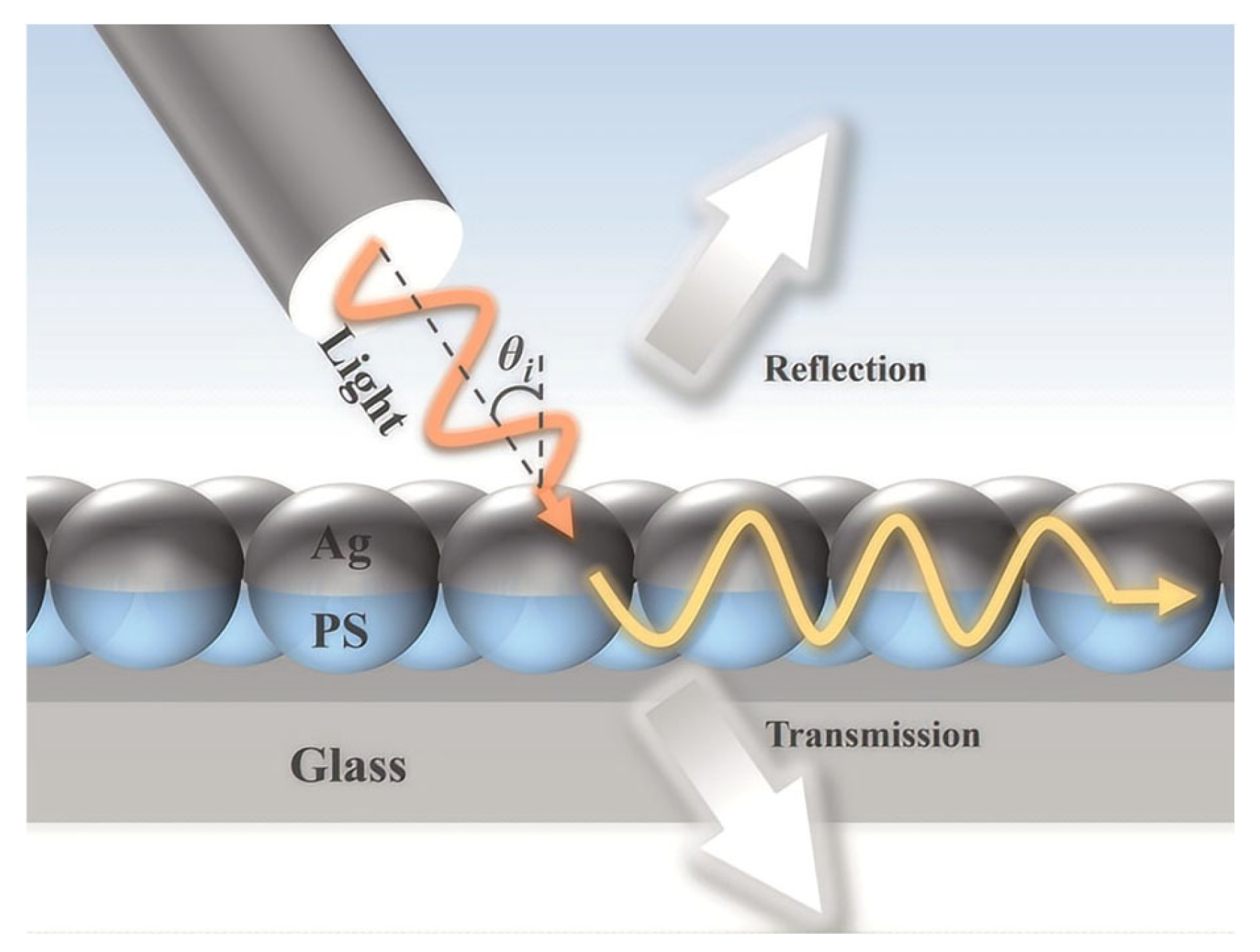
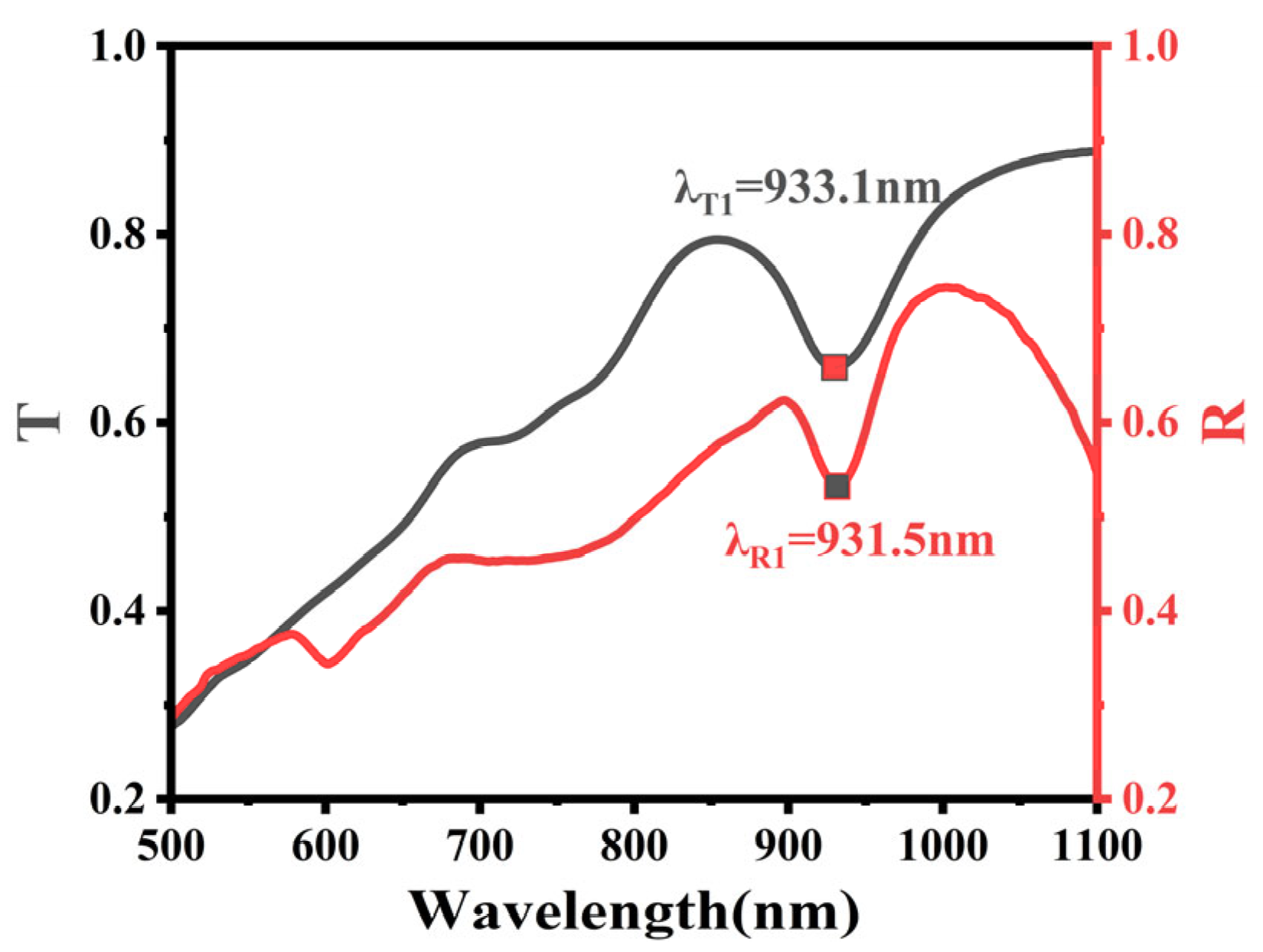
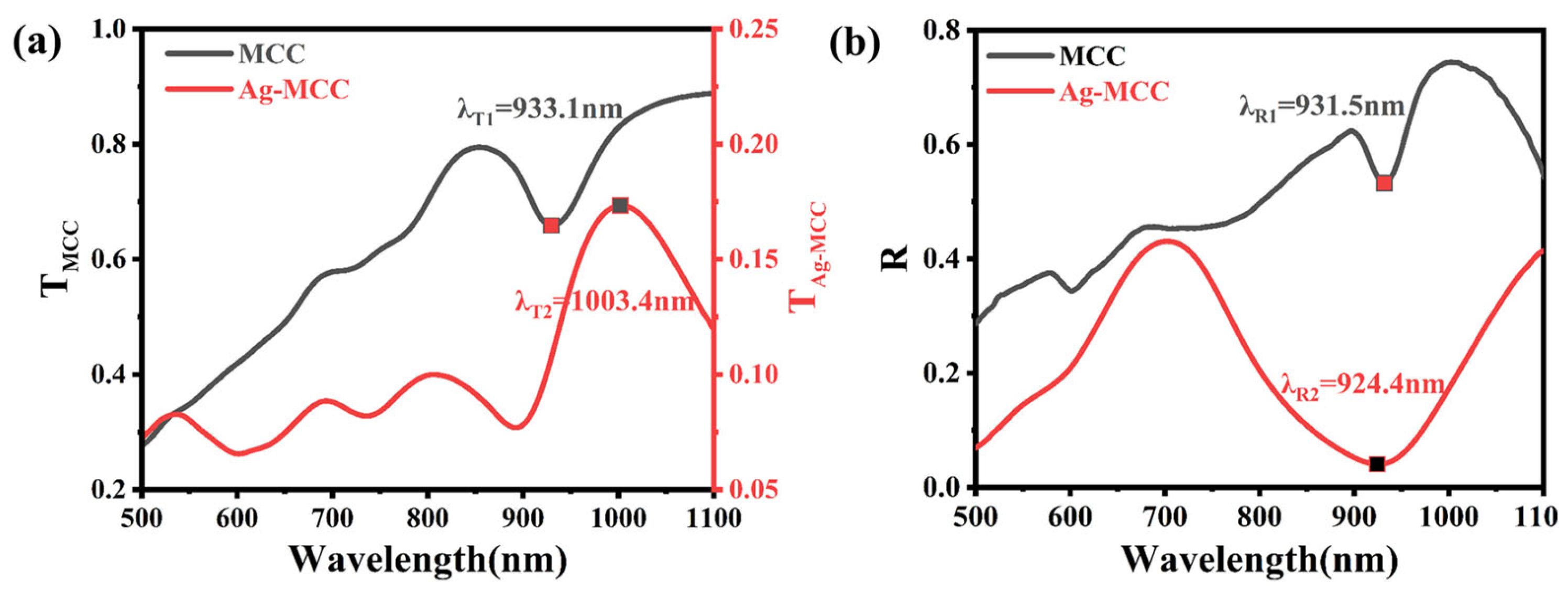
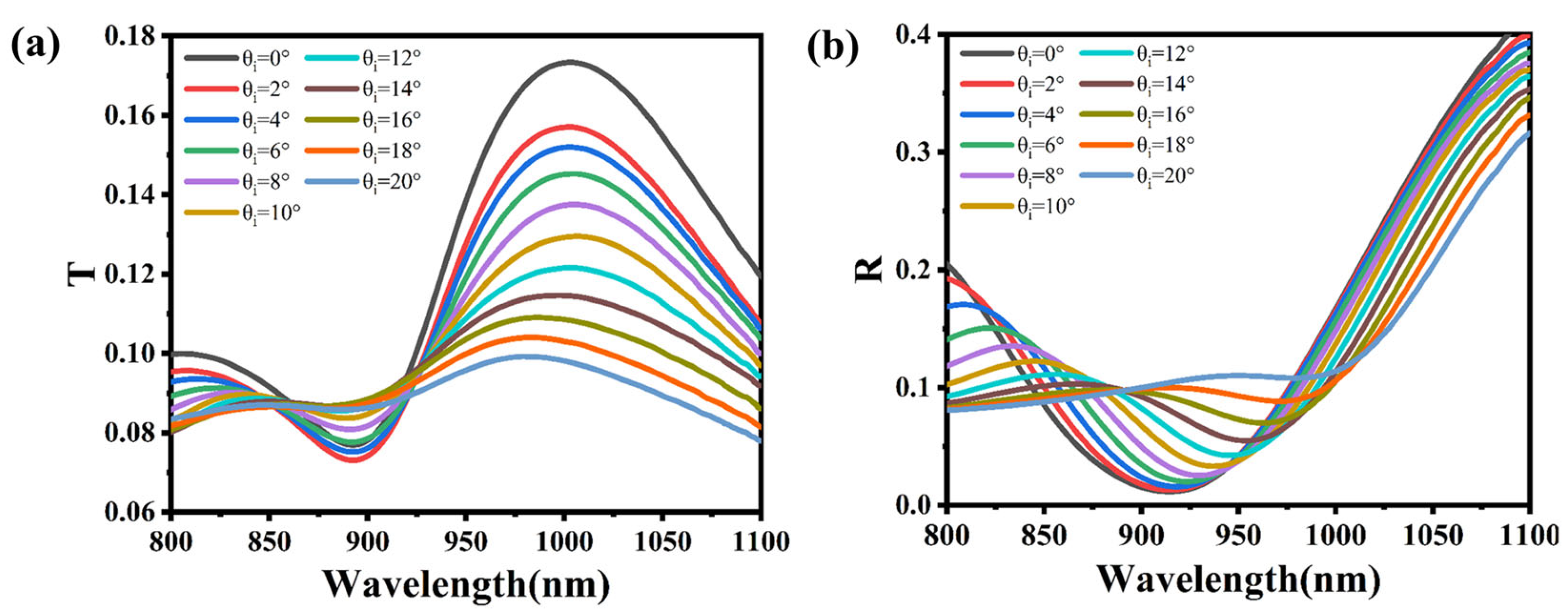
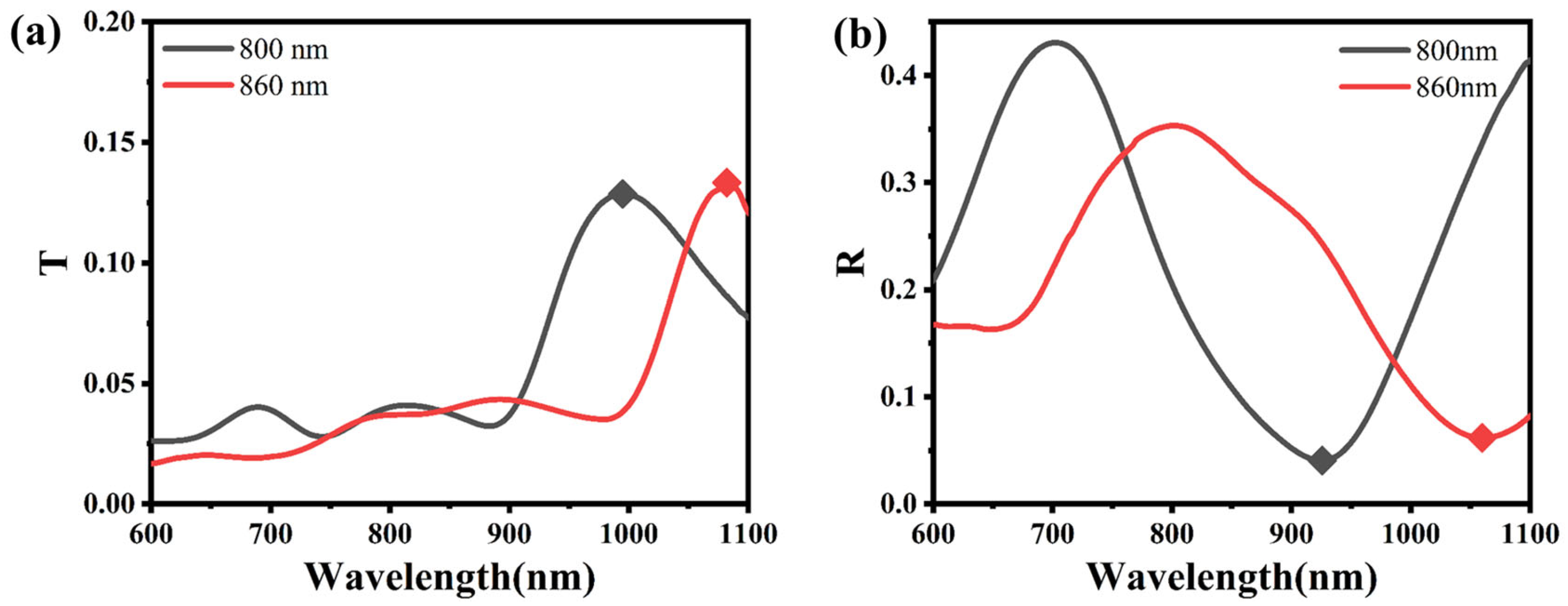
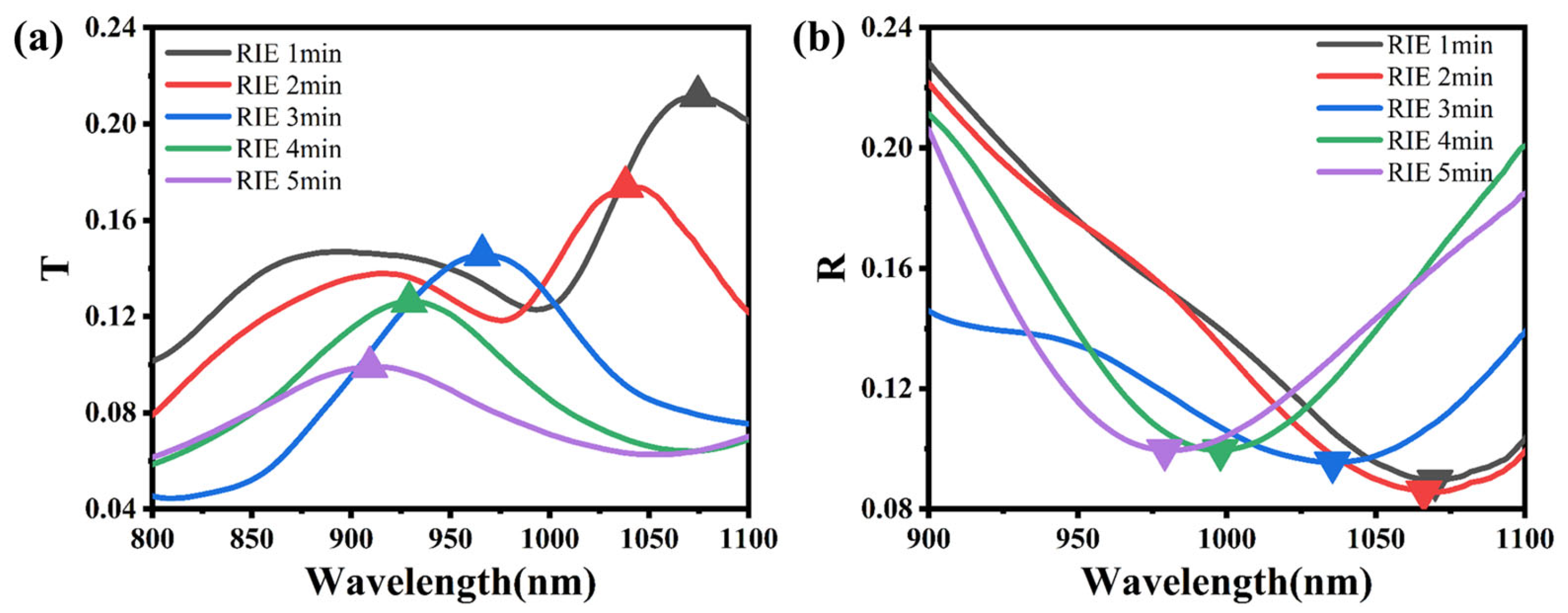
Disclaimer/Publisher’s Note: The statements, opinions and data contained in all publications are solely those of the individual author(s) and contributor(s) and not of MDPI and/or the editor(s). MDPI and/or the editor(s) disclaim responsibility for any injury to people or property resulting from any ideas, methods, instructions or products referred to in the content. |
© 2025 by the authors. Licensee MDPI, Basel, Switzerland. This article is an open access article distributed under the terms and conditions of the Creative Commons Attribution (CC BY) license (https://creativecommons.org/licenses/by/4.0/).
Share and Cite
Li, P.; Xie, Z.; Yan, H.; Zhong, S. Photonic–Surface Plasmon Coupling Mode: Experimental Study with a Silver Thin-Film Coating on MPCC. Photonics 2025, 12, 811. https://doi.org/10.3390/photonics12080811
Li P, Xie Z, Yan H, Zhong S. Photonic–Surface Plasmon Coupling Mode: Experimental Study with a Silver Thin-Film Coating on MPCC. Photonics. 2025; 12(8):811. https://doi.org/10.3390/photonics12080811
Chicago/Turabian StyleLi, Pengfei, Zhanwu Xie, Haitao Yan, and Shitong Zhong. 2025. "Photonic–Surface Plasmon Coupling Mode: Experimental Study with a Silver Thin-Film Coating on MPCC" Photonics 12, no. 8: 811. https://doi.org/10.3390/photonics12080811
APA StyleLi, P., Xie, Z., Yan, H., & Zhong, S. (2025). Photonic–Surface Plasmon Coupling Mode: Experimental Study with a Silver Thin-Film Coating on MPCC. Photonics, 12(8), 811. https://doi.org/10.3390/photonics12080811




